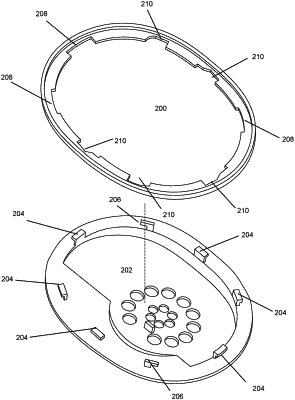| CPC H04R 1/1058 (2013.01) [H04R 1/1008 (2013.01)] | 8 Claims |

|
1. A method for securing a headphone ear cushion to a headphone earcup, the method comprising:
orienting an ear cushion proximate to, but not touching, an earcup;
where the ear cushion comprises an attachment ring comprising:
a first elliptical ring having a flat face;
a first notch, a second notch, a third notch, and a fourth notch along the inner edge of the first elliptical ring;
where the earcup comprises an attachment receiving interface comprising:
a second elliptical ring having a flat face;
a first outward-facing hook, a second outward-facing hook, a first tangentially-facing hook, and a second tangentially-facing hook;
aligning the first notch in the attachment ring with the first outward-facing hook on the attachment receiving interface, the second notch with the second outward-facing hook, the third notch with the first tangentially-facing hook, and the fourth notch with the second tangentially-facing hook;
pressing the flat face of the first elliptical ring against the flat face of the second elliptical ring such that the first outward-facing hook pass through the first notch, the second outward-facing hook passes through the second notch, the first tangentially-facing hook passes through the third notch, and the second tangentially-facing hook passes through the fourth notch; and
rotating the first elliptical ring relative to the second elliptical ring in a direction such that each of the hooks of the attachment receiving interface engage with a flat portion of the attachment ring.
|